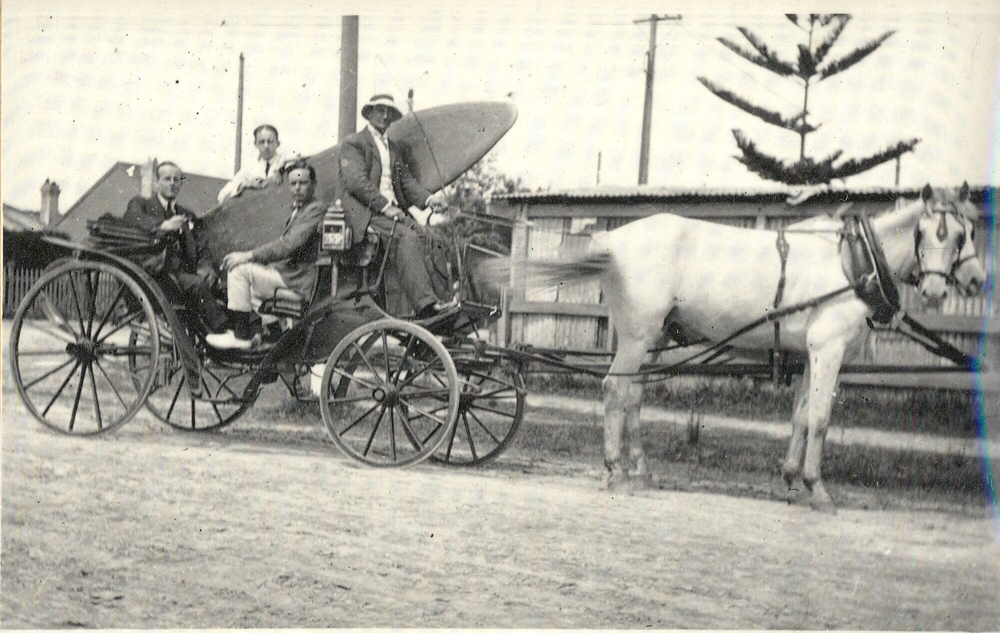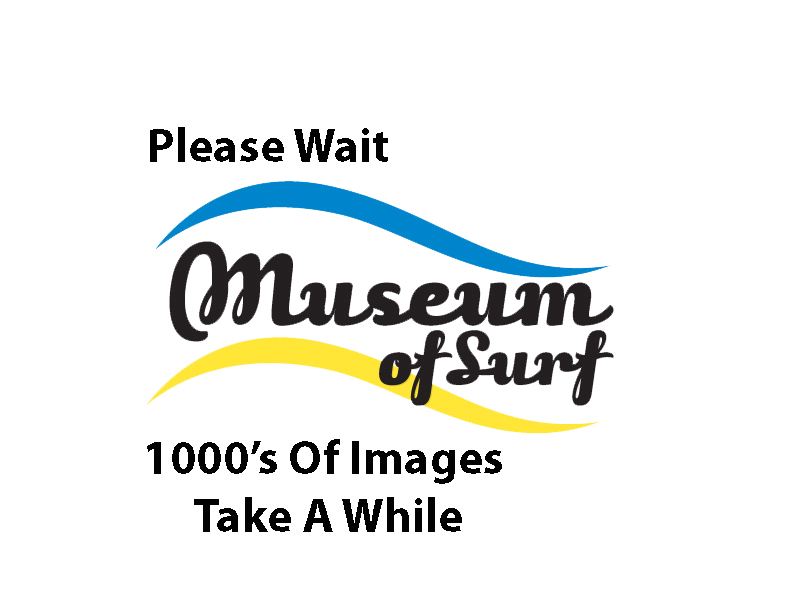The History Of Surfing

History Of Surfing
This an ongoing page, and is a work consisting of research and memories. If you have something to offer or disagree with the information contained on this page. Feel free to contribute. rob@museumofsurf.com
Duke Kahanamoku gave an exhibition of surfing at Freshwater Beach in Sydney in 1914. I don’t think anyone who viewed that display, could envision what a profound effect it would have on the youth of Australia. There were already people surfing the surf lifesaving rescue boards of that era. The Duke, however, made a board from sugar pine, it was the only wood he could find in Sydney’s timber mills. He said at the time, it was too heavy but will still work. The Duke as he is affectionately called was in Australia for the Olympic games and was a champion swimmer of the time. The board was made by the Walker brothers, and the Duke gave the board to them in gratitude for their help during his stay. The Walker brothers later gave the board to Claude West who was in awe of the Duke and surfed all his life. He then gave donated the board to the Freshwater surf club, and to this day is proudly displayed in a glass case. From these basic beginnings,
Australians adopted surfing into its outdoor lifestyle. Although it was only the adventurers, of the time that pursued, surfing as a lifestyle, not just part of it. Surfing is such a freedom of expression and some say an art form. Most Australian’s went about their everyday lives in suits and hats, but it soon became a breakaway culture and surfers began to wear different clothes, that suited the beach lifestyle. The world war was to change a lot of what was considered culturally acceptable, and the returned soldiers who had been through the horrors of the war adopted the freedom of surfing and a culture of having fun. Australian’s have always loved the outdoors, but through the 1940s and early ’50s, the surf culture was growing at a rate that no one anticipated. This was also the beginnings of the breakaway from society. Young men had a battle with parents and sometimes employers to conform to the normal boundaries of society. In 1956 a group of Americans’ arrived in Australia, with a new style of lightweight Malibu surfboards, resulting in another change in the surfing culture. These guys were super fit and the boards were so differents The Malibu surfboard could be turned and trimmed on a wave something virtually impossible on the heavier boards. They were made of lightweight balsa and coated in an alien substance called fiberglass. This was the end of the plywood and heavier timber boards, but the birth of surfboard manufacturers all over Australia as many of the major brands we see today set up factories and began to build the custom order surfboard. Around this time the breakaway from the surf lifesaving clubs formed a rift between the surfers, who only wanted to have fun without boundaries, and the lifesavers who were the heroes of the beach, but extremely regimented, which is still the case today, but in fairness to the life-saving movement, they have to be as they are there to patrol the beach and save lives every day.
The surfers would take over the best break, even if it was between the flags and the lifesavers went out of their way to make sure the flags were set up, in the best break. The local councils decided the only way to keep surfers out of the flags was to regulate them. Registration of surfboards became compulsory and a registration sticker was issued for your board. If you were caught between the flags, your board was confiscated and a fine issued for the offense. As you can imagine, this was open warfare between the clubbies as they were called and the hardcore surfers. Without the benefits of a leg rope, a board would wash up between the flags and be confiscated.
The more aggressive surfers just battered the clubbies and walked away. Throughout the ’50s and early 60″s, the surfing culture was characterized in the Gidget movies. Young fit suntanned, beach bums who had strayed so far from the student, job, family, and mortgage of the average young person. The tag surfie started to be used by the conformists and was meant as a degrading tag of the lifestyle surfers loved. Although other breakaway groups were forming, such as the rockers who wore the leather jackets and slick back hair. The bikies, similar to the rockers, but rode noisy motorbikes and so began the battle of the young men, who considered they were the kings of breakaway cultures.
Surfers really weren’t interested in fighting and causing too much trouble; they only had eyes for the surf and beach. They soon learned they were not going to be left to have fun, as the rockers skinheads and bikies decided to invade the beach and beat up the surfers. Testosterone was flowing everywhere, so surfers being fit and agile had some outrageous rumbles with these alternate groups, and I remember my father who couldn’t understand any of this era, commenting why do they want to fight you.
The parents during these changes in society must have been through hell, as all the normal values began to change to having a lifestyle of pleasure more so than work. In 1956 with the advent of television and movies, showing surfing waves at places like Waimea Bay and other exciting locations, spurred the surfers of the time to travel. The grass is always greener attitude, was born. Surf bums saved enough money to buy a cheap old bomb and loaded it with boards. Traveling up, down and long the vast coastlines of Australia, discovering new and isolated surf locations.
It was the excitement of surfing a break that no one had ever even seen before that kept the surfers of the era searching ever more coastline. There is no way to explain this feeling, I experienced it a few times after traveling down tracks and digging the car out of bogs and sand drifts, only to find a perfect point break, with nothing but beach and waves. Absolutely unbelievable feeling!!! This virtually non-existent today, except maybe in remote overseas countries, but even these are something akin to the unicorn. As surfing was beginning to irritate the mainstream and the youth were rebelling against conformity, a natural progression led to an alternate culture.
To attempt to understand part of this part of history, you would need to know some of the underlying animosity that the surfer became accustomed to. Surfers grew their hair longer than was socially acceptable, society decided to humiliate anyone who’s hair was past their collar. For example, I was given six cuts of the cane every day at school in front of the whole assembly, which only made me rebel even further. I was made to wear a hairnet when I went for my driver’s license, even though my girlfriend had hair down to backside and she wasn’t asked to wear a net. I am certain this form of oppression is the reason most surfers are anti-racism and are more tolerant of other cultures etc.
At the same time, the Beatles and Rolling Stones changed the music everyone was tuned to. The boards were lighter than the timber boards, however, they were still too long to transport comfortably, so unless you lived across the road from the beach, or you had a great Dad, you had a problem. This was the time of Store A Board surf shops which sprang up along the beaches. You could leave your board at the beach and pay storage fees. From memory, these were the first surf shops other than the manufacturer’s showrooms. The 60’s through to the ’70s, was an era of inventiveness, surf movies, and the surf magazines, surf music all showcasing, the latest in fashion, trends in board design. The early board builders adapted to the new innovations in surfboard design, and some of these are still big names in the industry today. The likes of, Barry Bennett surfboards from the Northern Beaches. Brian Jackson surfboards, (Jacko) from Southside, Joe Larkin in Queensland. Many others that taught us the trade, only to see many of their protégé’s open up down the road building their own brand of boards. There was no such thing as a contract, just an agreement of loyalty for a certain time. It was this type of system that further separated the surfing community from the mainstream. It was also part of the divide between the stars and the average surfer, some of whom surfed just as well if not better than the movie and competition stars. These were known as the soul surfers, as they had no interest in the glory of the magazines or movies, they just wanted to surf. There were a few who dabbled in both camps, some like Wayne Lynch, who at times was in every competition around, only to drop out of the scene for a while then re-emerge. Wayne was an enigma and all through his life all he wanted to do was surf. In a tribute to Wayne in one of the latest movies, he was described as a black dot. This is one of the best descriptions of Wayne I have ever heard. If you were ever driving along the great ocean road in Victoria and you saw something way out the back, all by itself but you couldn’t really tell what it was, until a set came in and then the black dot soon became Wayne. The big names of this era are far too many to name here, but I will attempt to add as many as I can to the Legends section of this site.
Nat Young with his aggressive attitude to every wave. Midget Farrelly, with his fluid, artistic style. Bob McTavish the larrikin of the bunch. Bob McTavish is still considered the most innovative of the surfboard builders of this era, although a Californian Kneeboard rider, George Greenough, surfaced as probably the most influential designer, in the history of surfing. The ’70s was the shortboard era as boards went from 9′ down to 5′ in seven years, and they were amazing times and all us old blokes will tell you that this was the best era of all, as we had to change our style of surfing to suit the equipment nearly every year which may sound easy but the style used on a longboard is totally different to a shortboard. On a longboard you had to walk up and down the board to manoeuvre different sections of the wave and your rear foot had to be over the fin to turn the board whereas the shorter the boards became, you could turn the board from nearly anywhere and surfing became more radical as the shortboard allowed you to do almost vertical maneuvers, impossible on the longboard. I can recall Col Smith from Narrabeen doing vertical backhand re-entries that won him a lot of contests and respect from the surfing community.
The ’70s were a radical change not only in the style of surfing but in the attitude to surfing in general, I think in some ways we lost the spiritual feeling that surfing commands and it became all about how good you were instead of the all-inclusive attitude of the pioneers. In some ways, it was maybe a good thing as it paved the way for the mainstream media and corporate sponsorship that validated surfing with the population. Major companies began sponsoring winning contest surfers and the birth of major surfwear labels, such as Billabong, Quiksilver, Rip Curl, Ocean & Earth, Balin just to name a few.
This was also the era of the major contests with sponsors offering a year’s wages as prize money. Michael “MP” Peterson won the first Stubbies contest at Burleigh Heads and a year’s salary. No story of surfing history can leave out the influence of MP as he was a freak of nature when he hit the water. Often thought to be a recluse and a big head as he wouldn’t talk to too many people and shunned a lot of the limelight. It wasn’t until after the Stubbies win that it became common knowledge that MP was suffering mental illness. Over the years I have known an extraordinary number of surfers that suffered from mental illness and the less informed blamed the drugs, but I knew guys that never touched drugs but suffered none the less.
It is my opinion that as with all of us when you arrive at the beach and see a left and right A-Frame peak with no one out, the endorphins kick in and as you paddle out the troubles of the world are left behind. Billabong once quoted that Only A Surfer Knows The Feeling. There is no other quote more befitting the difference surfing has on a person and explains one of the reasons that surfing tends to take over your life. I have participated in nearly every other pastime, sport or anything else that compares! The respect for the ocean and mother nature is another offshoot that most surfers acquire along the way, to be immersed in the ocean and feel it’s power cannot really be explained in words, but I will say there is no other feeling like it.
While I think there may be some errors in this artwork. The following artwork was supplied by Total Surfing Fitness. A great example of sharing. Thanks, Guys.



